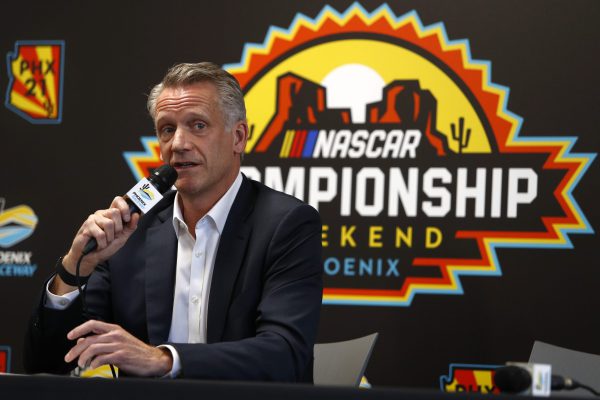
By Reid Spencer NASCAR Wire Service
NASCAR president Steve Phelps stuck to his guns.
In his first state-of-the-sport press conference after taking office in 2018, Phelps acknowledged that NASCAR racing faced significant headwinds but proclaimed, “I do believe as we head into 2019 that our best days are ahead.”
The 2021 season has given Phelps no reason to retract that statement, and the promise of 2022, with the introduction of the Next Gen car for the NASCAR Cup Series, only serves to enhance the optimism.
“The first time I had the opportunity to do this was in 2018 in Miami,” Phelps said Friday at Phoenix Raceway during his fourth end-of-season session with reporters. At that particular point, the sport was going through some challenges, some headwinds, right? Those were real. I think we felt that.
“I remember using the phrase that our best days are ahead. I’m not sure everyone in this room or folks around the country, (or the) world, believed that to be true. I did. I think the results that we have seen are more than encouraging. I’m very proud of them, right?
“It really took an industry coming together in order to make that happen. It took race teams, our broadcast partners, our sponsors, tracks that we own or tracks that we don’t own, that all came together to create an opportunity for our sport to grow, which is exactly what’s happening.”
Emblematic of that growth is the continuity of NASCAR’s presence on television, a reflection of the sanctioning body’s agility in completing a full 36-race 2020 NASCAR Cup Series schedule despite the complications of the coronavirus pandemic.
“We are the most stable sport on television since 2018,” Phelps asserted. “No other sport—none—can match what NASCAR has done from a stability standpoint with our ratings. If you consider our share numbers since 2019 in our Cup Series, it’s up 18 percent, which is hard to do at this point. It’s just hard.
“Then you look at our ratings for Xfinity and our Camping World Truck Series, they’re up double-digits. The share in both of those series is up 25 percent to 30 percent. We are having a moment as a sport. It’s important that we keep it going, which is exactly what we’re going to do.”
Growth in attendance, fueled by imaginative scheduling, has paralleled the increase in television share. Phelps said every NASCAR-owned track, with the exception of Darlington, showed an increase in per-event attendance over 2019—and Darlington added a race in 2021.
Notable, too, were road course additions to the schedule at Circuit of The Americas in Austin, Texas, and Road America in Elkhart Lake Wis.
“I think the schedule variation is critical for the success of this sport,” Phelps said. “I think you saw really strong results from schedule variation, whether you’re talking about COTA, you’re talking about Road America, you’re talking about even format changes like Bristol Dirt, which might as well have been a new venue.
“Ben Kennedy (senior vice president of strategy and innovation) and the team put together the most aggressive schedule we’ve had in 50 years. I think it worked. Attendance was fantastic at all the new venues. The racing was good at all the new venues.
“As we look to the schedule in 2022, going to the L.A. Coliseum to kick off our debut with our Next Gen car as a proof point, frankly, to we’re going to be bold in what we’re doing, whether it’s the schedule or the car—all of it—we’re going to take calculated risks.”
Though NASCAR is still addressing steering and heating issues with the Next Gen car in advance of its debut in the Feb. 6 Clash at the Coliseum, the car is on course for its inaugural race. Currently, there are no problems with the supply chain for the components.
“What I would say is that this car has been tested, run, (with) more collaboration than any other new car in the history of this sport,” Phelps said. “Not even close. The Gen-6 car that came out, we ran a test in January before we raced it at Bristol for the first time.
“I am confident, and we check all the time on supply chain issues. As of now, there are no issues. We’ll continue to monitor that because it’s important. If you’ve got 30 major components to the car, (and) you only have 29 of them, you have a problem. Until the car is on the race track, we’ll continue to give it all the attention that it deserves, which is a lot.
“With respect to issues with the car that we’re working through, right now it’s really down to two things that we see, which is steering, which you guys have talked about, and getting that right. The other is the heat in the car. We’ve got some solves for that that the drivers I believe are feeling more satisfied with.”
Phelps also indicated that NASCAR is having conversations with new manufacturers about entering the sport. One prevalent rumor has Dodge returning to competition.
“There are some discussions that are going on with other OEMs, new OEMs, that would come into the sport,” Phelps acknowledged. “Our three existing OEMs are happy about that. Our race teams are happy about that. We’re happy about that. It’s been widely rumored that Dodge is one of those or closest. I won’t confirm or deny that.
“It is important. We’ve made no bones about the fact that we want to have a new OEM in our sport. I think we got delayed with the pandemic. With that said, we are an attractive place, I believe, for OEMs to come into the sport. Now is an important opportunity for them to do that because of the Next Gen car.
“I also believe the fact that the sport is growing and has a relevance that it hasn’t had in decades is causing some real interest from other OEMs.”





